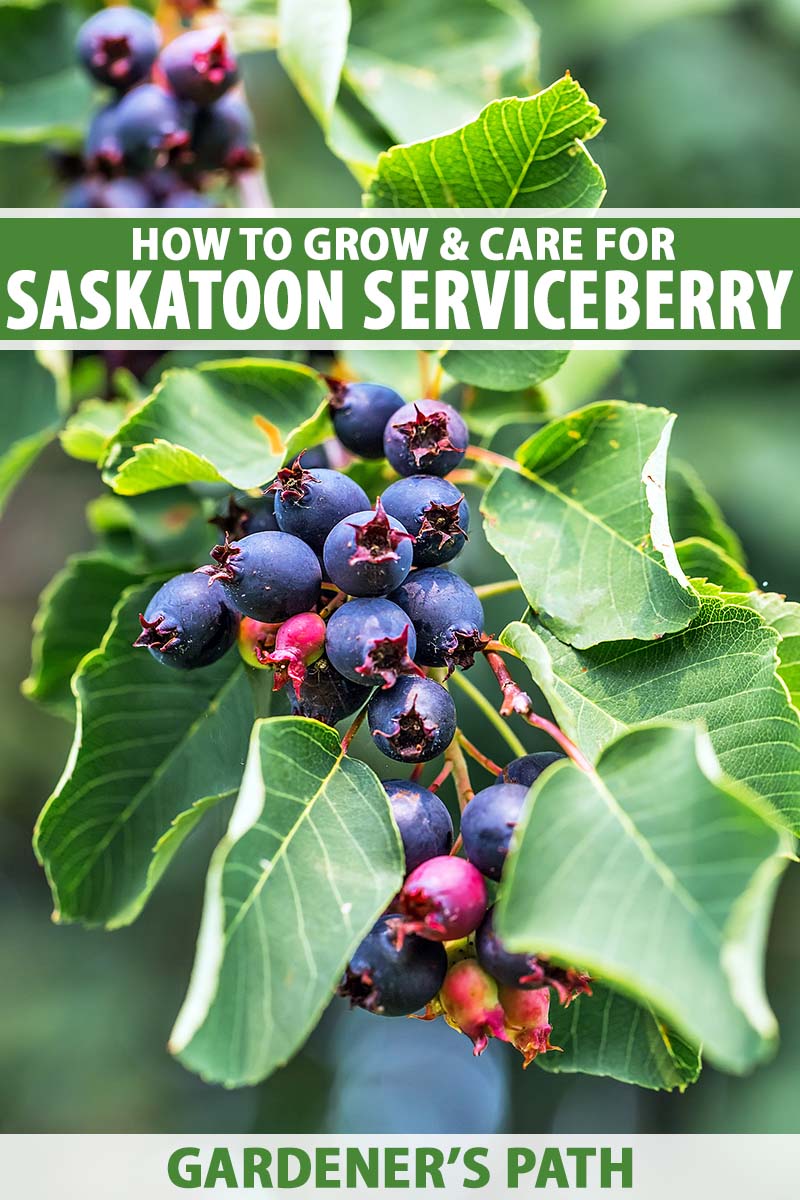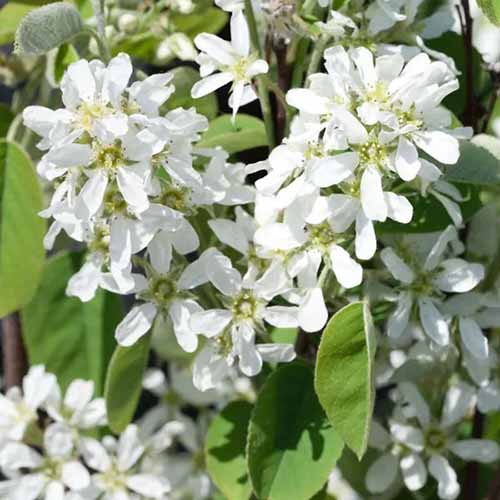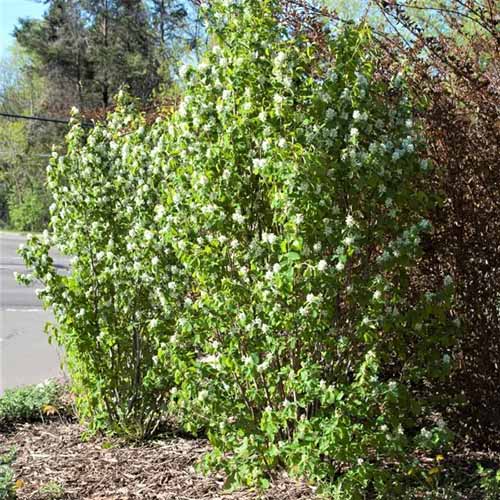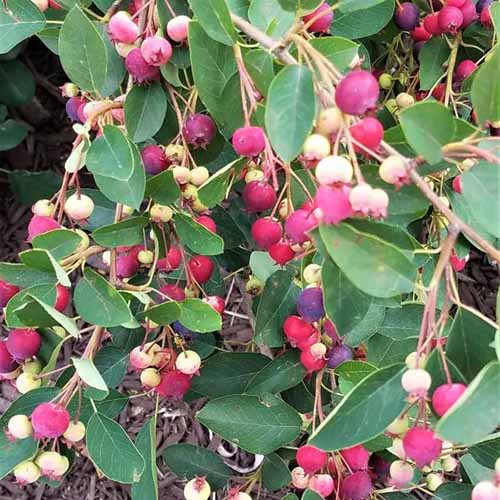Amelanchier alnifolia
Years ago when the idea of growing a food forest was first introduced to me, I began to research which trees and shrubs were the best choices to lay the foundation of my urban gardening plan.
The Saskatoon serviceberry stood out like a rockstar and I was immediately drawn to this native shrub.
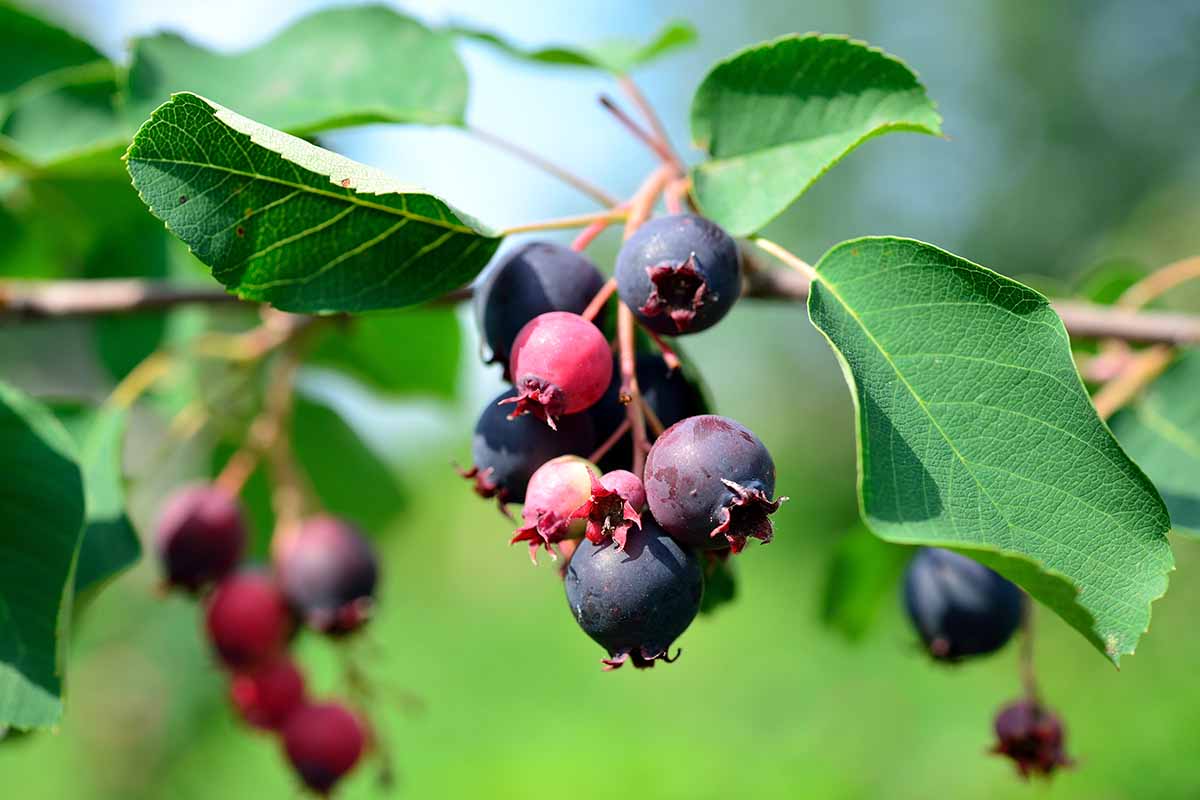
We link to vendors to help you find relevant products. If you buy from one of our links, we may earn a commission.
It was hard to ignore the stunning beauty of the delicate white flowers that promised me a lovely spring fragrance, a bounty of edible fruit, and the bonus of biodiversity in my gardens.
After learning more about this native species, I came to love and respect it in a truly intimate way.
This shrub is known for its environmental benefits, and is often used in reclamation efforts and erosion control.
It’s the perfect addition to riparian zones and makes fantastic shelter belts. And hey, not only are the plants easy to care for, but those nutritious berries taste mighty delicious too!
So when I had the opportunity to spread the word about how much I love the Saskatoon, I couldn’t pass it up. I’m honored to tell you more about the Saskatoon serviceberry.
Here’s a look at what I’ll cover in this article:
What You’ll Learn
If you’re excited to learn more, let’s get started, shall we?
What Is a Saskatoon Serviceberry?
Saskatoon serviceberry, Amelanchier alnifolia, is a flowering, fruit-bearing deciduous shrub, native to the northwest region of the United States and western Canada.
It grows wild in the northwestern part of the continent, extending from California up into Canada as far north as Alaska, and east to Minnesota and Ontario.

It sometimes goes by other common names, including alder leaf shadbush, western Juneberry, Pacific serviceberry, western shadberry, western shadbush, western serviceberry, and pigeon berry.
Saskatoons belong to the Amelanchier genus, which is a member of the Rosaceae family, along with many popular fruit trees such as apples, cherries, and plums. You can learn more about the genus in our guide to growing serviceberries.
Within the A. alnifolia species are several different varieties as well as a number of cultivars and hybrids. We’ll cover some of these later in this guide.
Although commonly mistaken for other species in the Amelanchier genus, Saskatoons can be distinguished by inspecting their leaves.
Like all serviceberry species, the leaves have an oval to round shape. But where they differ is around the margin, or edge, of the leaf.
While most serviceberry leaves are finely toothed around the entire margin, or outside edge, in the case of Saskatoons, the edge of the lower half near the petiole, or stem, is smooth. Only the upper half, or the tip-end, of the leaf is toothed around the edge.
Some varieties of Saskatoons can grow up to 26 feet tall, but most only reach a maximum height of 18 to 20 feet tall if left unpruned.
Conversely, the common serviceberry, A. arborea, can reach up to 40 feet tall at maturity. Saskatoons usually grow in the form of a multi-stemmed, clumping shrub rather than as a tree.
Saskatoon shrubs thrive in USDA Hardiness Zones 2 through 9.
In their natural habitat, Saskatoon plants can be found growing wild along bluffs, forest edges, moist stream banks, and rocky shorelines, as well as on hillsides, and in open wooded areas, swamps, and thickets.
They grow rapidly after natural and mechanical disturbances like fire, logging, and mass forest defoliation as a result of pest infestations.
As a perennial shrub, A. alnifolia changes throughout the year, not only producing edible fruit, but aromatic and visual seasonal interest as well.
In spring, it begins the season with clusters of delicate white, slightly fragrant flowers.

Soon after the buds begin to open, the leaves emerge. The alternate, green leaves are one to two inches long.
Saskatoon flowers are self-fertile, meaning the flowers will pollinate each other. Although they don’t require a pollination partner, they produce more fruit when planted in groups of two or more.
The juicy, round berries are called pomes, they ripen from green to red, and finally to a dark purple or black in early summer when they’re ready to pick.
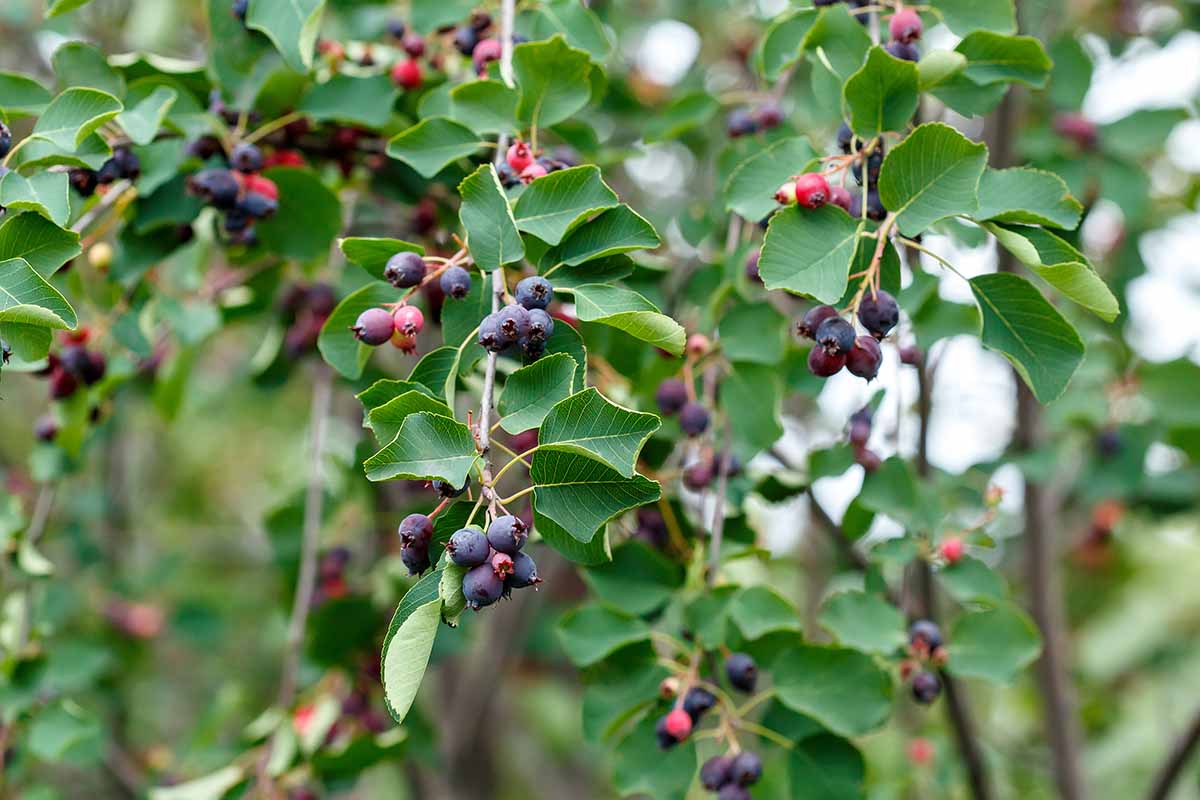
These pomes resemble blueberries in size and color, and have a sweet, nutty taste. They grow to an average size of half an inch in diameter.
Saskatoons are commonly used in jams, jellies, and pies, among other delicacies. Also used medicinally, they have a colorful cultural history which I’ll expand on later.
The fruits are an important food source for bears, birds, squirrels and other wildlife, while the foliage is enjoyed by deer and elk.
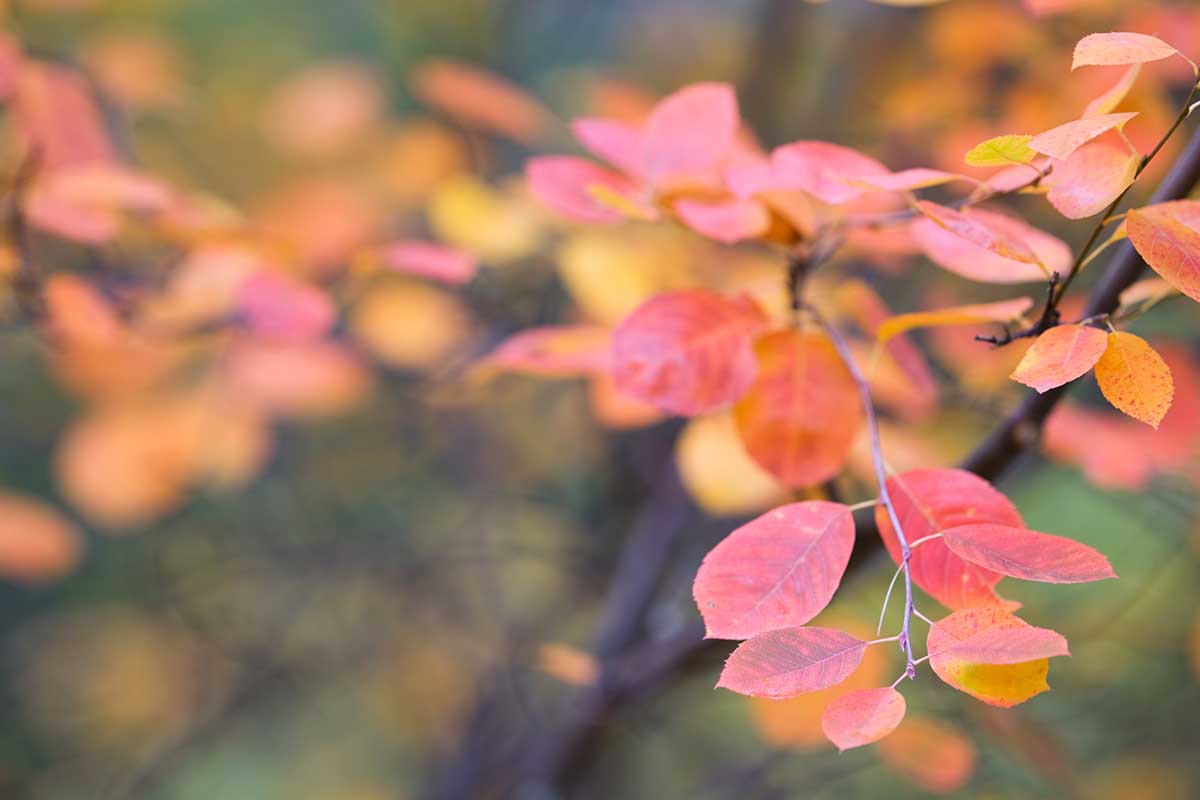
The green leaves turn gold, red, and burgundy in fall, adding ornamental value to the autumn garden.
Leaves fall away in winter, revealing the bare stems, or trunks, adding interest during the cold months.
With its cheerful spring blooms and vibrant autumn color displays, the Saskatoon serviceberry is an ornamental favorite for many North American gardeners.
It’s also low maintenance and easy to care for, making it a perfect food-producing addition to home orchards, permaculture plots, and urban food forests.
Cultivation and History
English botanist and zoologist, Thomas Nuttall collected, studied, and classified many North American plants during early expeditions between 1808 and 1841, including the Saskatoon.
He first classified the plant in a published document in 1818 as Aronia alnifolia.
The word Saskatoon is derived from the Cree word misâskwatômin (mis-sask-quah-too-mina), which translates as “saskatoon berries.”

The city of Saskatoon in the province of Saskatchewan, Canada, shares the name, which makes good sense as the city lies geographically in the middle of the plant’s native range.
Historically, Indigenous peoples across North America consumed these berries in various forms – fresh, dried, mashed, or cooked.
They also used Saskatoon berries as a natural sweetener and combined them with animal fat and meat to produce pemmican, a dense, high-energy food.
Beyond their culinary uses, Saskatoons were relied on for medicinal purposes. In traditional Indigenous medicine, they are believed to have cleansing and rejuvenating effects on the body.
They were used to treat liver diseases, disinfect wounds, prevent miscarriages, and as a laxative. The Blackfoot people used the berries to manage diabetes.
The twigs and branches of the Saskatoon plant also served medicinal purposes, used in cold remedies, general tonics, contraceptives, and treatments for gastrointestinal issues, and the leaves were used for making medicinal teas.
Saskatoons were also utilized for purposes outside of diet and health. Young branches of the plants were crafted into ropes, and the wood was fashioned into tools like arrows, baskets, and spears.
In contemporary times, Saskatoon berries have gained recognition as a “superfood” for their numerous health benefits.
The Saskatoon pome, or berry as it’s often called, is nutritionally dense, containing a range of vitamins and minerals including potassium and various B vitamins, as well as fiber and tocopherols.
A 100-gram serving of the berries provides 60 calories, healthy levels of fat and protein, and is particularly high in carbohydrates and fiber.
These berries are rich in beneficial compounds like terpenes, phenolics, glycosides, and alkaloids, with a higher polyphenol content than many other berries, indicating strong antioxidant and anti-inflammatory properties.
These fruits are delicious in pies, puddings, marinades, and jams. If you haven’t tried eating them fresh or cooking with them, you’re in for a treat! We’ll touch on some suggestions for the use of Saskatoons, and I’ll share a few recipe ideas later on in this article.
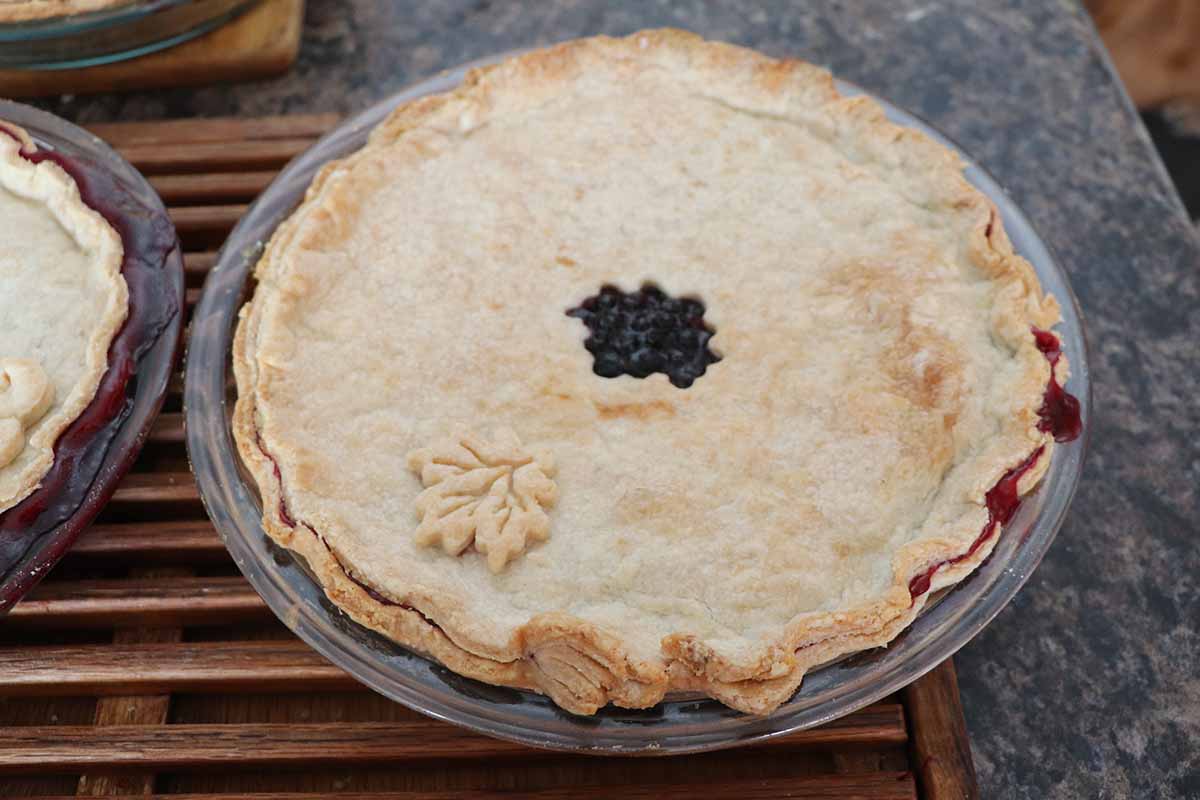
The growing popularity of Saskatoons eventually prompted their commercialization, with American and Canadian growers cultivating and selling these shrubs since the 1960s.
Orchards have also commercialized berry production, selling fresh and frozen fruit directly to consumers and processors. You can even find u-pick farms in many regions, where you can enjoy the activity of harvesting your own Saskatoons!
Now that you’ve learned the cultural significance, history, and nutritional value of A. alnifolnia, you’re likely curious to learn more about how to grow it yourself. So, let’s dive in deeper, beginning with propagation.
Saskatoon Serviceberry Propagation
Saskatoon serviceberry can be propagated from seed, from cuttings, by separating and transplanting suckers, and by transplanting purchased container-grown plants from nurseries and greenhouses.
From Seed
When propagating Saskatoon from seed, it is most often a case of, “you never know what you’re going to get.”
In the wild, there is no control over cross-pollination, so if you collect seeds from a plant you like, that seed might not produce a new plant true to its parent.
Some retailers sell Saskatoon seeds and you can also collect seeds yourself. Each pome, or berry, produces a single seed.
To grow from seed, collect the fruits as soon as they ripen and clean them immediately to prevent fermentation.
Carefully remove the pulp surrounding the seed, then gently wash them in water and allow to air dry before storing in a sealed, refrigerated container. Seeds can be stored for up to five years.
Seeds that have been stored will benefit from four weeks of warm stratification before 90 to 120 days of cold-moist stratification.
Begin with the warm stratification process. Soak your seeds in water for 24 hours, then place the seeds in a handful of damp soil into a plastic zip top bag and seal it, then set the bag in a warm spot in your home for the four week period.
Check the contents every two or three days to make sure the medium is moist and isn’t growing mold.
If you see mold, don’t panic! Just remove your seeds, rinse them thoroughly and prepare a fresh bag of damp soil, then continue the process.
After four weeks, move the bag to your refrigerator for cold stratification. If you live in a temperate climate and you’ve got an uninsulated porch, garage, or greenhouse your seeds can also spend time there through the winter.
After three to four months of cold stratification, prepare a shallow container or a tray with potting soil and plant the seeds about a quarter of an inch deep.
Moisten the soil and cover the tray with plastic and then set the tray somewhere warm with indirect light. Keep the soil moist and check it regularly to make sure it doesn’t dry out completely.
Germination will occur anywhere in roughly 30 to 40 days, but in some cases can take up to 18 months.
After successful germination, wait until the plants are at least an inch or two tall before potting them up.
Transplant the seedlings into individual pots, four to six inches in diameter, and keep them in a sheltered outdoor location until they reach about six to seven inches tall. Transplant them into the ground in early spring or late fall.
If you stratified your seed indoors through the winter and sowed the seeds in the spring, they should be ready to plant in the ground by fall of the same year, which is the ideal timeline.
Unless you’re an experienced gardener or propagation enthusiast, this method might seem lengthy and complicated.
You can avoid doing the work involved with stratification by letting nature do the work for you. Just sow your freshly collected seeds directly into the ground in the fall.
Sowing seeds in the fall exposes them to natural temperature changes through the winter and spring, which is really what seeds need for successful germination.
Beyond growing from seed, let’s investigate the other ways to get started with Saskatoons.
From Cuttings
Saskatoon serviceberry plants can be rooted by taking hardwood or softwood cuttings, but softwood cuttings have a higher rate of success.
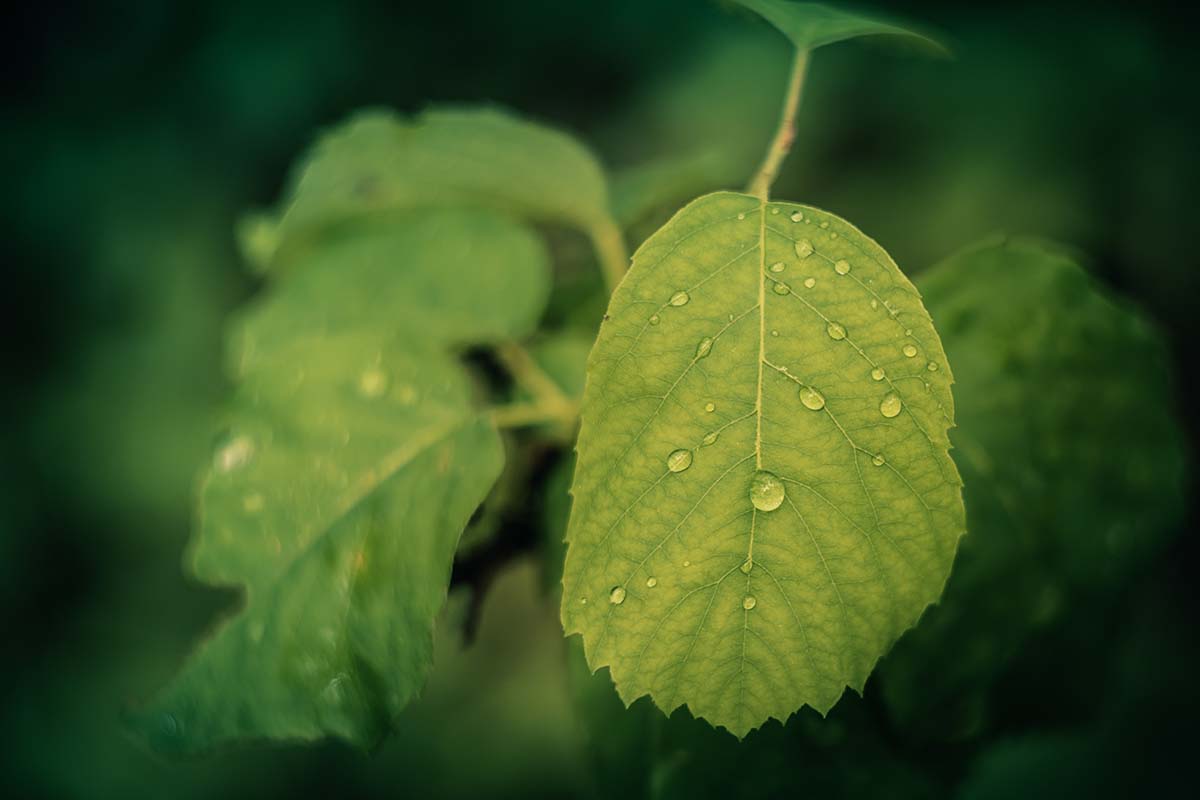
If you plan to take cuttings from a wild shrub, I recommend tasting the fruit first to make sure it’s to your liking.
For softwood cuttings, in mid to late June, remove a young, tender branch with a sharp knife. This piece should be about six inches long.
Prepare a container with potting mix or soil. This container should be at least four to six inches deep to provide ample room for root development.
Pinch the leaves off of the lower half of the cutting and remove any flowers if they’re present. Make a clean cut just below a node, where a leaf is attached to the stem.
Dip the cut end in rooting hormone and stick this end into the soil in your container about two inches deep. Moisten the soil with water and then cover it loosely with a plastic bag or sheet of plastic to retain moisture and warmth.
These cuttings should be growing roots by August, and will be ready to transplant outdoors by fall.
Suckers
Since most Saskatoons send out suckers freely, growing new shrubs from these suckers can be an easy and inexpensive way to produce more plants.
Suckers can be removed in spring or fall. To separate a sucker from the main plant, clear the soil away from the sucker you wish to remove and dig down carefully to expose the roots where it’s attached. Cut the sucker away from the main plant with a clean knife or sharp, clean shovel.
Transplant the divided sucker directly into the ground in a sandy bed. If you’re planting in the spring, provide shade with a shade cloth as the hot weather approaches and maintain even moisture through the first summer.
If you’re planting in the fall, make sure you keep the soil evenly moist until plants begin to go dormant in your Zone.
Transplanting
The fastest and most reliable method for obtaining a new Saskatoon serviceberry shrub is by purchasing one from a reputable greenhouse or nursery.
This ensures you’re receiving and planting the kind of Saskatoon you want, while at the same time cutting down on time spent propagating seeds, cuttings, or suckers.
Once you select your specimen and bring it home, you’re ready to plant – easy peasy!
To transplant, start by digging a hole that’s twice as wide and just as deep as the root ball of your specimen.
I usually use soil inoculants, or mycorrhizal fungi in my new planting regimen to ensure my plants will have a successful transition to their new home.
I like Root Build 240, and it is available from Arbico Organics.
If you’re unfamiliar with this topic, you can read about soil inoculants in our guide to learn more.
Next, you need to remove your Saskatoon from its pot. Give the container a couple of good squeezes around the outside to loosen the roots, then shaking it gently, slide the root ball out of the container.
Now it’s time for inspection. Examine the root ball and remove any damaged or dead roots.
If the roots appear tightly bound, untangle them with your fingers. Sometimes if my transplants are extremely rootbound, I’ll use a clean, sharp knife like my hori hori, to cut them apart.
Make two or three vertical cuts on the outside of the root ball about one-half to one inch deep and then use your fingers to tease the roots loose.
Once the roots are free, place your shrub into the hole. The top of the root ball should sit at the same level it was in its original container. To adjust the height, dig your hole a little deeper or scoop some soil back into the hole.
If you want to discourage suckers, you can try planting your Saskatoon about one to two inches deeper than it was in the nursery pot.
Don’t forget to add your inoculant, if you’re using one, and follow the instructions on the packet.
If you’re happy with the placement of your plant, it’s time to tuck your Saskatoon into bed.
Backfill the hole with soil, tamping gently around the roots as you work. This helps to settle in the soil around the roots and release pockets of air.
Then grab the hose or fill up a bucket from your water collection tank and give your shrub a drink.
Finally, add a three- to four-inch layer of mulch to the base of your new transplant, covering the root zone – just don’t pile it up against the stems.
Aim to keep the mulch a few inches away so it doesn’t make contact with the stems. This is important as wet mulch can cause rot to form on the stems and roots.
Congratulations! You’ve successfully planted your new Saskatoon. Let’s move on to learn all the variables that will allow it to grow to its full potential.
How to Grow Saskatoon Serviceberry
Like many native species, Saskatoon serviceberry plants are not overly demanding, and can withstand some stress.
But if you want to provide the best conditions for your shrubs to thrive, you should give them what they need to live their best lives.
Saskatoons grow well in USDA Hardiness Zones 2 to 9. These shrubs can tolerate some partial shade, but full sun locations will help them to produce larger yields of high-quality fruits.

If you’re planting these shrubs for ornamental purposes only, they can take a bit of shade – but if you’re hoping to harvest juicy, sweet berries, you’re better off choosing a full sun location.
Saskatoons prefer well-drained soil with a pH range of 6.0 to 8.0. While they’ll grow in sandy soil, and will even tolerate clay soil, they perform the very best in fertile, loamy soil.
So, as with the full sun variable, if your goal is to produce good quality fruit and achieve high yields, aim to plant in loamy soil.
Depending on the variety, Saskatoons grow at a slow to moderate rate. They will typically begin to produce fruit at about three to four years old, but will reach full production after about six to eight years.
As I mentioned earlier, depending on the variety and growing conditions, Saskatoons can reach a maximum height of about 26 feet tall if left unpruned. These plants also sucker from the base, expanding their root zone as they mature – they can spread up to 10 to 20 feet wide if the suckers aren’t removed or controlled.
For this reason, when you’re planning your planting site and location, think ahead about spacing for these plants. Check the label or nursery tag for the maximum height and width of the variety you’re planting, and space according to the mature size.
Keep in mind that you can control the size of Saskatoons through regular pruning, which I’ll discuss a little later on in this article.
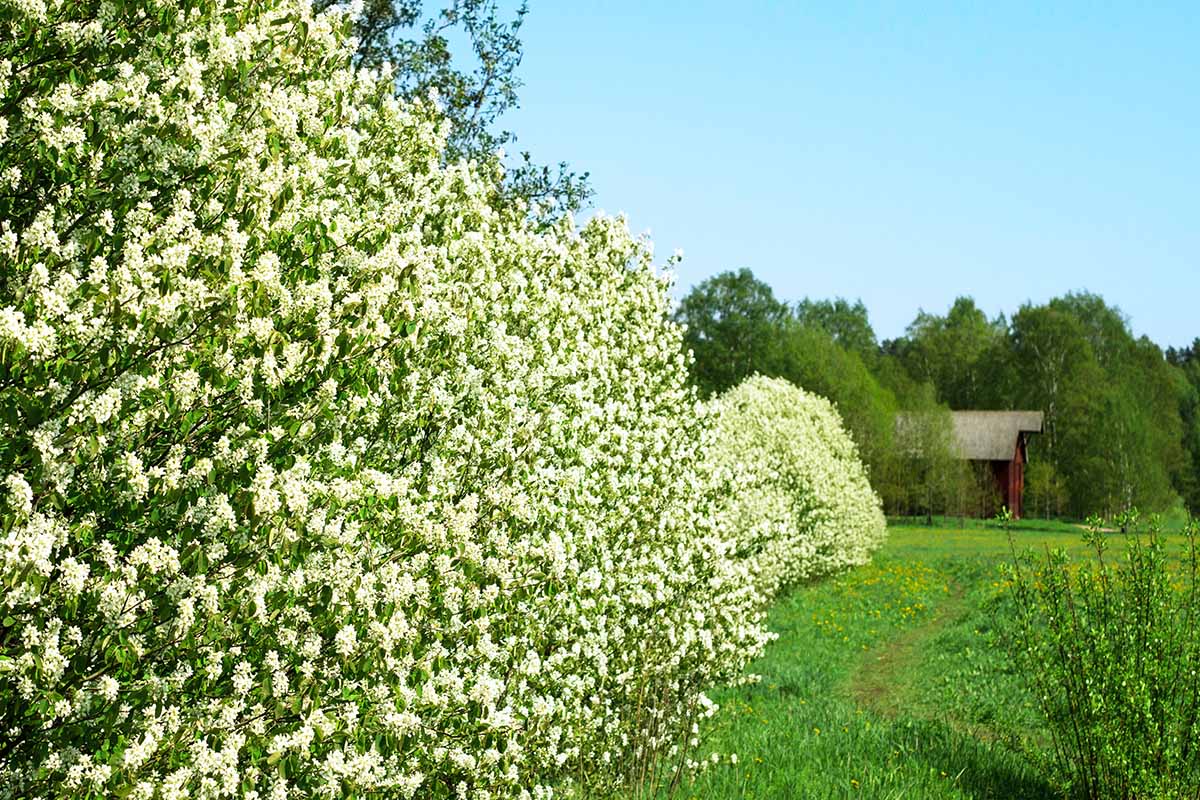
Saskatoons are fairly drought tolerant, in their natural habitat, they can survive on the amount of water they receive through regular rainfall.
How much water should you give them and how often? New Saskatoon plantings require consistent moisture until they’re established. This means you should feel the soil three to four inches beneath the surface and if it’s dry, give it a drink of water.
Once established, you can transition to a regular watering schedule as needed based on your local weather conditions.
When these shrubs are new, water them at the base near the stems. After they become established, aim to water them all the way out to the dripline where the feeder roots are located.
If you receive regular rainfall, you shouldn’t need to provide any additional water. But if your region is experiencing a dry spell or drought, you should give your serviceberry additional water to ease the stress of the unusually dry conditions.
During exceptionally dry times, use a spade or shovel to dig down in the dirt within the root zone of the shrub about six to nine inches. If the soil is cool and damp, you don’t need to water. If it is dry, then it’s time to irrigate.
Growing Tips
- Choose a location with full sun for maximum fruit production.
- Plant in loamy, well-draining soil with a pH of 6.0 to 8.0.
- Provide additional water during dry spells or drought.
Pruning and Maintenance
Since Saskatoons grow at a slow to moderate rate, you won’t need to spend a lot of time pruning. You can remove diseased or damaged wood at any time.
Pruning to control or maintain shape and size should be done in the fall or winter when it’s easy to see the bare branches.
Every two to three years, remove a few branches from the base of the shrub. This will allow light to reach the interior of the plant and will also encourage adequate air circulation between the branches.
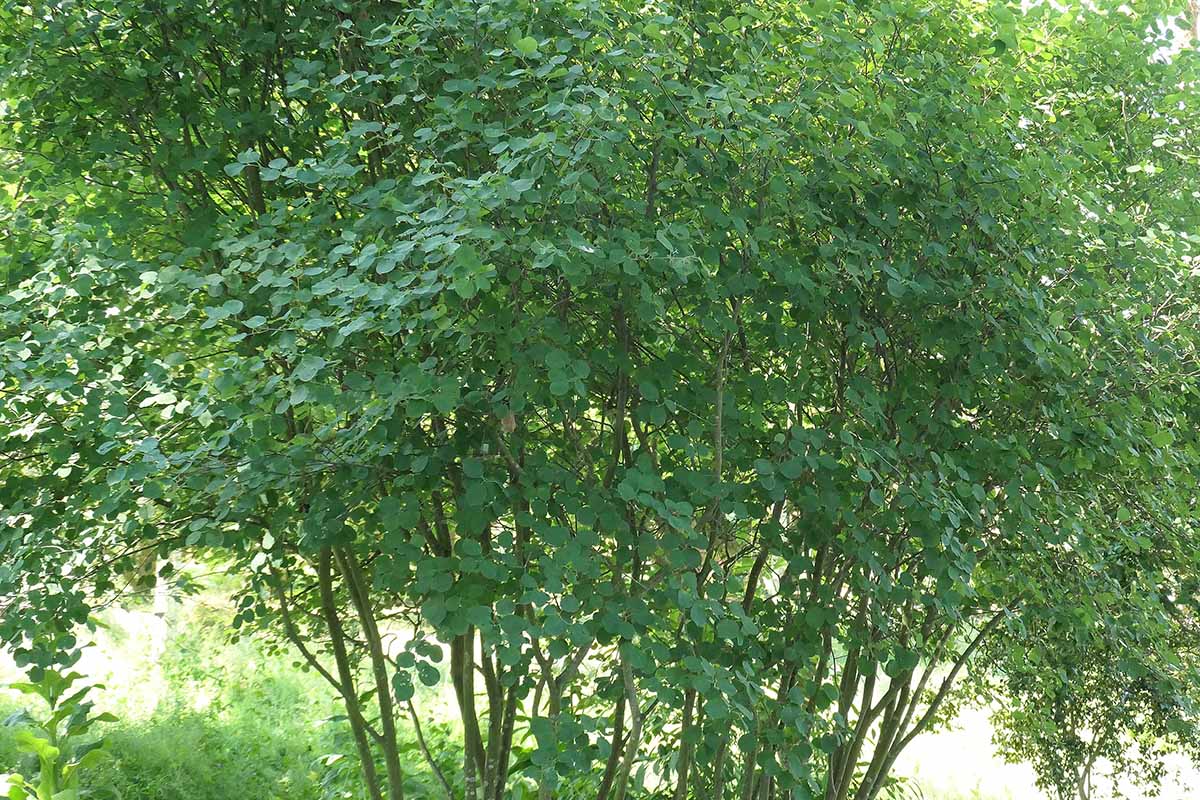
As your Saskatoon shrub becomes less productive with age, you can chop the whole plant down to about six inches above the soil surface.
This hard pruning will rejuvenate the plant and when it grows back it should start producing fruit within two to three years.
Suckers might be desirable if you’re trying to grow a hedge or fill in a large open area or plot of land. But if you’re trying to control the spread of your plant, you’ll need to remove suckers as needed.
You can remove suckers at any time of the year, but I recommend making this part of your regular maintenance routine, in either the spring or fall.
Each spring, top up the layer of mulch around the root zone of your trees. Expand the area on the ground outward as the plant grows to match the drip line. The drip line is approximately equal to the spread of the branches above ground.
Mulch breaks down as it ages through the year and as it does, it builds and adds nutrients to the soil. It also creates a barrier on the surface of the soil that helps to conserve moisture and keep weeds at bay.
Organic mulches like wood chips are my recommendation. I mix my wood chips with composted manure at least every other year to provide additional nutrients for my fruiting trees and shrubs, including my Saskatoons.
Like many native plants, Saskatoons don’t require heavy fertilization. Also, their shallow root systems absorb fertilizer more quickly than other shrubs do. For this reason, definitely avoid applying fertilizer to new transplants.
Fertilizer should only be used if your soil is nutrient deficient. Test your soil to determine if additional nutrients are needed.
If you apply fertilizer, go with an organic balanced fertilizer, with an even ratio of nitrogen (N), phosphorus (P), and Potassium (K), like 10-10-10, and feed your plant once in early spring.
Also, if the package doesn’t give you specific instructions for Saskatoons, limit the amount to less than half of what you’d normally use to fertilize other shrubs.
To improve your soil naturally, you can boost the populations of good bacteria and microbes by amending with well-rotted manure or compost, and protecting the ground with mulch or ground cover plants.
We need to talk about weeds. Some gardeners detest weeding, but I actually enjoy it. It’s like a calming meditation for me, and very gratifying to pull out a weed with its roots intact, like if I’ve won a prize!
Since Saskatoons have a shallow root system, weeds and grass can compete for nutrients, and this can stunt their growth.
If you’ve mulched around the base of your shrub, weeding shouldn’t take too long as mulch suppresses weed growth. Do a visual check once per week and pull out any offenders.
Saskatoons don’t require any special winter care. The only thing I would suggest is that you provide protection from hungry herbivores.
During the winter, if other vegetation is scarce, tender trunks and stems can become a desirable snack for animals like rabbits. So, protect your plant with some kind of barrier. I’ll discuss this further on in the article, so read on for more information.
Saskatoon Serviceberry Cultivars to Select
Since Saskatoons grow in Zones 2 through 9, you’ll likely find a species plant, variety, or cultivar suited for your local growing conditions at a nursery or greenhouse near where you live.
If you can’t find them sold in brick-and-mortar shops, or if you prefer the convenience of online shopping, you can buy them from online sellers.
You can find species plants available at Nature Hills Nursery.
To give you an idea of what else is available, here are a few standout cultivars:
Lee 8
‘Lee 8’ is a hybrid cross of ‘Northline’ and ‘Thiessen,’ bred by Lee Lloyd in Alberta, Canada. It grows in Zones 2 to 8 and maintains a compact, upright shape.
This cultivar is slow-growing, reaching a maximum size of six feet tall and wide, making it a good choice for home gardens.
The fruits of ‘Lee 8’ are of exceptional quality and flavor and are ready to harvest in early July. This cultivar is known for minimal suckering, and it offers vibrant orange to red fall foliage.
Northline
Originating in Beaverlodge, Alberta, Canada, ‘Northline’ grows in Zones 2 to 8.
The shape of this cultivar is upright and spreading, and it suckers freely. ‘Northline’ reaches about 10 to 13 feet wide and if allowed to sucker, can reach up to 20 feet wide, making it a good choice for hedging, or where it has space to sprawl.
This cultivar’s fruit is large and fleshy with a tangy flavor. The berries also usually ripen consistently at the same time, around the middle of July.
Obelisk
‘Obelisk’ aka Standing Ovation™ grows in Zones 2 to 8. Although the fruits are edible, it is mainly grown for its ornamental value. It grows in a columnar, erect shape, up to 12 feet tall and four feet wide.
It flowers profusely in spring and the foliage turns yellow in fall.
The smaller berries attract birds, making it a good choice for natural landscapes with the goal of conservation and habitat regeneration. ‘Obelisk’ also makes a good hedging shrub.
You can find container-grown Standing Ovation™ ‘Obelisk’ available at Nature Hills Nursery.
Regent
Developed in Regent, North Dakota, ‘Regent’ grows in Zones 2 to 7. It keeps a compact shape as it grows, reaching four to six feet tall and up to eight feet wide.
Its showy flowers open a little earlier in April, and the green foliage turns to vibrant yellow and red in fall.
This cultivar is commonly grown and sold in the United States, known for its vigorous production of high quality fruit.
Since it produces fewer suckers compared to other cultivars, it is a good choice for urban gardeners and landscapers.
You can find bare root and container grown ‘Regent’ plants available at Nature Hills Nursery.
Thiessen
Originating in Saskatchewan, Canada in 1976, ‘Thiessen’ grows in Zones 2 to 8.
This cultivar has a tall, upright, columnar shape. It reaches a size of 13 to 16 feet tall and up to 15 feet wide, and has a low rate of suckering.
‘Thiessen’ blooms early in the spring and the dark green foliage turns yellow in fall. This cultivar is known for its large, juicy fruits with good flavor.
It’s a prolific producer, and the berries ripen over a longer period of time, making it a good choice for home gardens or u-pick operations.
Managing Pests and Disease
As most native plants are, A. alfolia is not generally bothered by pests and diseases.
Foraging animals might take a nibble here and there, insects might do some minor damage, and some diseases might pose a threat, but overall these plants are pretty tough.
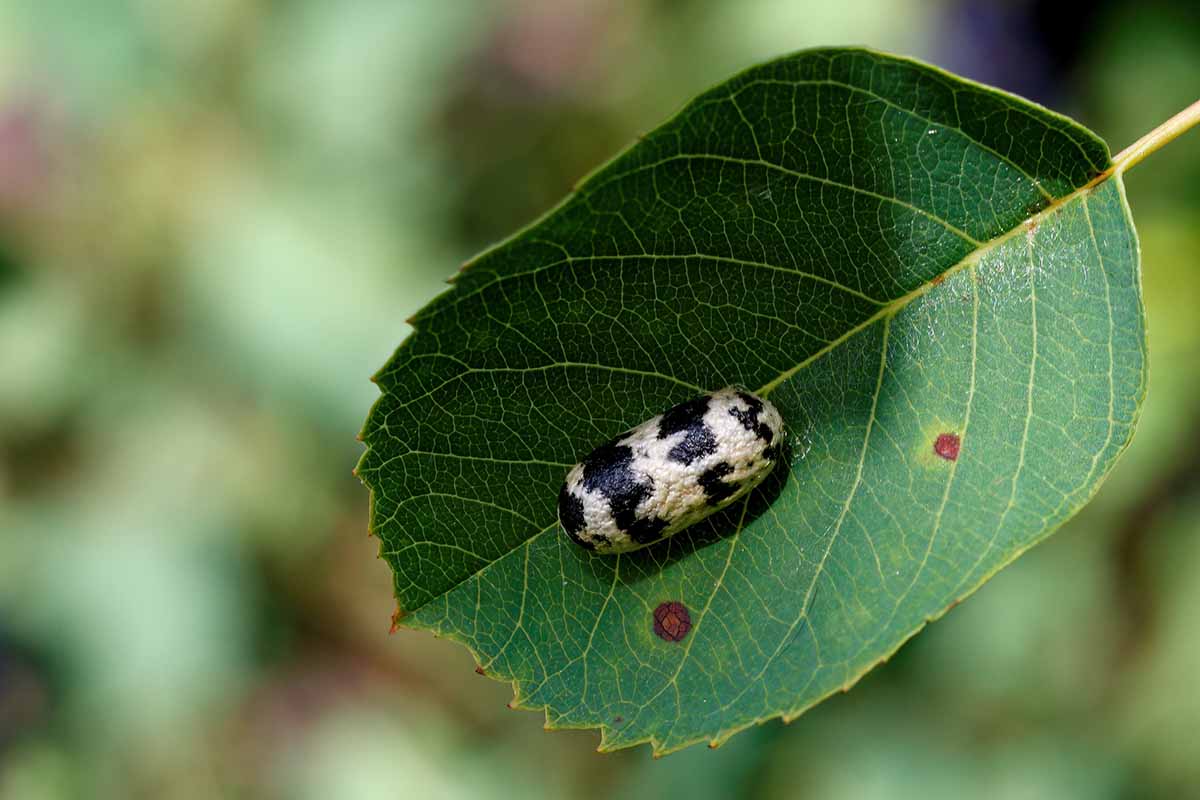
But if you’re like me, and your goal is to harvest enough fruit to eat and cook with, you’ll need to address any issues as they pop up.
So, let’s take a look at a few pests that might affect your Saskatoons.
Herbivores
Especially during winter, the tender bark of young fruit trees and shrubs can be a tempting meal for bunnies.
Although I like to share some of my berries and other fruits with wildlife, if stems of my Saskatoons are chewed to bits, this could significantly impact fruit production – meaning, there won’t be any. So, it’s wise to protect your young Saskatoon shrubs with a barrier, like fencing.
If you’ve mass-planted a hedge or large area as I have with my aronia shrubs, you can fence off the group of plants.
But for fewer plants that are spaced quite far apart, I protect them individually. Because Saskatoons are usually multi-stemmed, I recommend making an inexpensive and easy fence out of chicken wire.
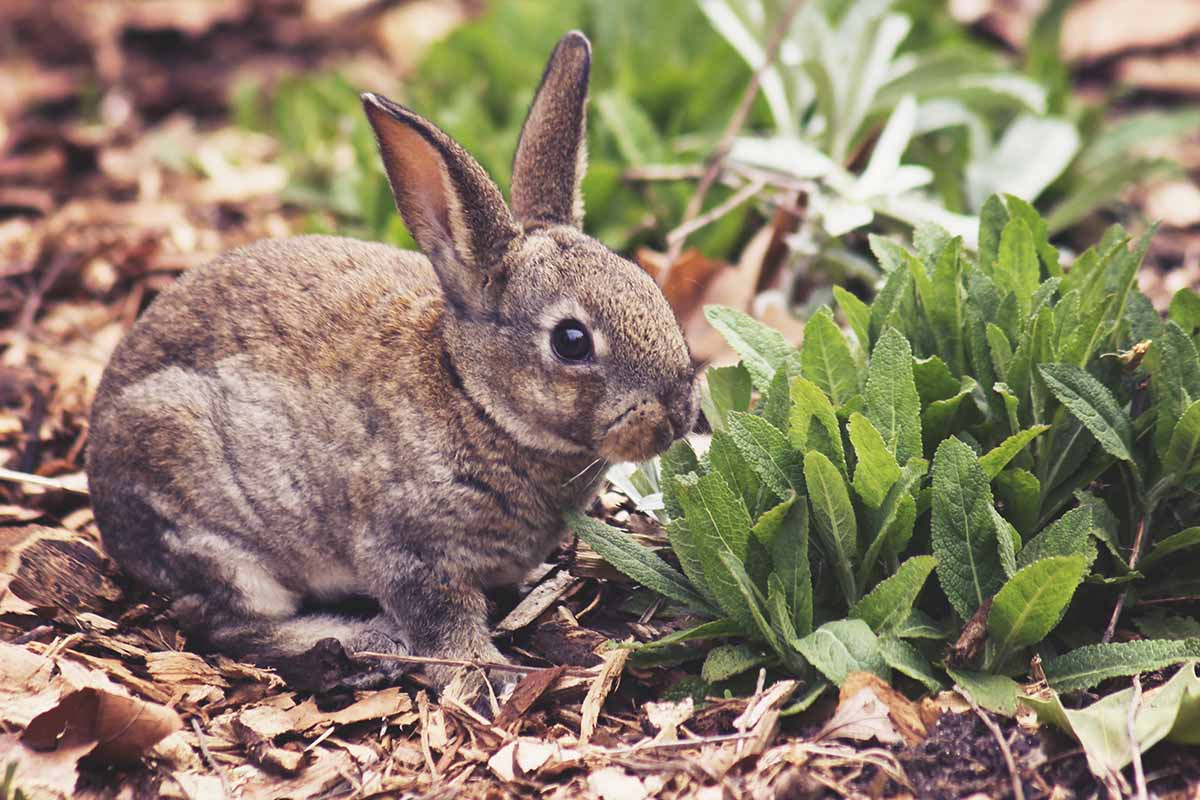
Cut lengths of chicken wire from a two- to three-foot wide roll, and then shape the lengths around the base of your shrub.
Secure the ends together by bending the cut wire in on itself and then tack it into the ground with stakes so larger animals can’t easily dislodge the fence.
You’ll need to make peace with the fact that birds can be a serious issue. When the fruits begin to mature, you can bet that birds have already scoped out their new feeding ground ahead of time.
Whether you plant extra shrubs to share with wildlife, or intend to keep the fruit all to yourself, you should prepare in advance of harvest time. Birds can pick your bushes nearly clean in a matter of hours.
Lightweight bird netting has saved my harvest on a number of occasions.
You can easily drape the netting over the top of your shrubs before the fruits ripen and leave it on throughout the harvest season.
Netting allows sun and rain through to your plants while keeping the birds out and you can easily lift it to pick and replace it afterwards.
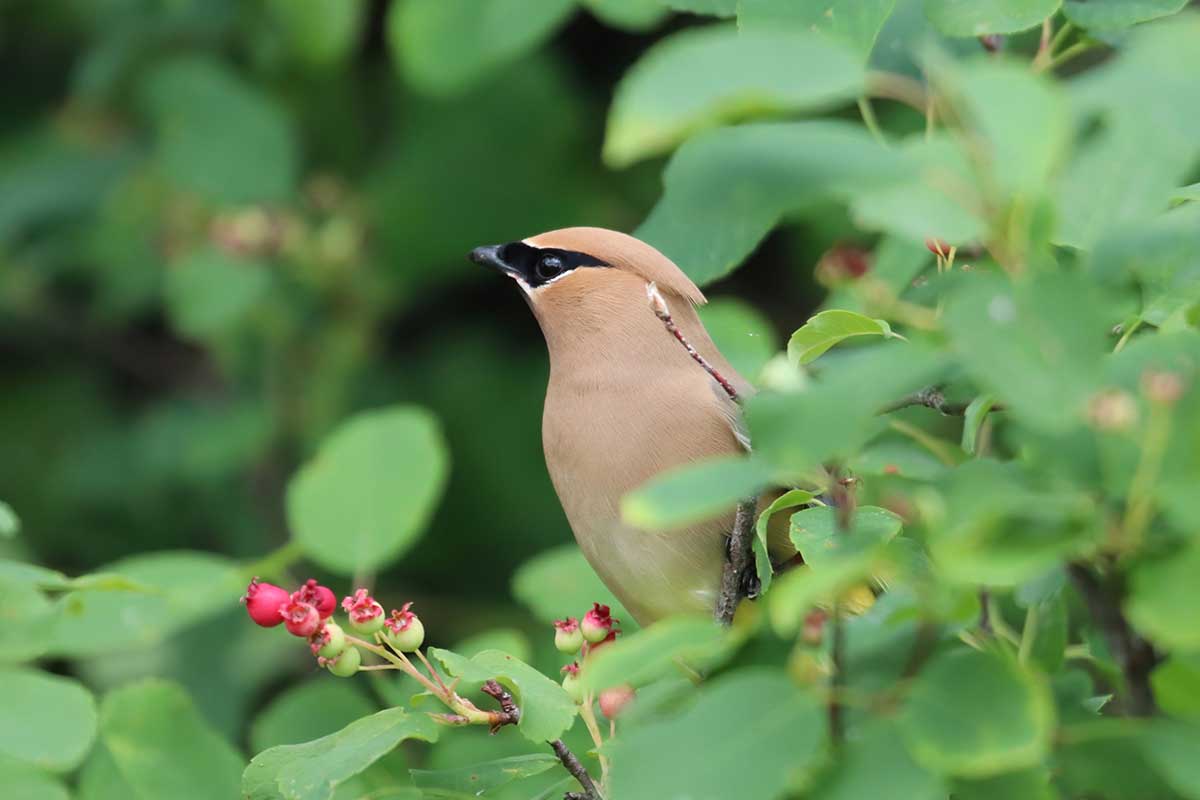
I recommend draping the netting all the way down to the ground, as it will keep birds from sneaking underneath.
Stake the edges of the netting into the ground or place rocks on the edges to keep inquisitive and creative creatures from finding a way in.
Once, a bird managed to get inside my netting, had a royal feast, and then it was unable to escape. I had to help it out, and let me tell you, it’s not easy to be nice to a naughty bird who left you with no berries!
Pests
Saskatoon serviceberry can withstand some insect damage, but if you’re aiming to reap a good harvest or have the best looking shrub on the block, there are a few bugs to watch out for.
Aside from common spider mites and woolly aphids, Saskatoons attract three specific insects, so let’s take a closer look.
Saskatoon Bud Moth
Saskatoon bud moths (Epinotia Bicordana) are small brown to greyish-black moths that emerge in early spring, usually in April.
Then, they mate and the females lay eggs near the base of flower buds and in crevices on twigs.
Eggs hatch in early May and then the larvae crawl to feed on developing flower buds. Larval feeding causes tiny holes on the flower buds and if you look closely, you might notice a little liquid oozing from these holes. Buds will turn yellow and usually fall off.
The larvae form a web around the growing shoots as they feed. Once the larvae can crawl, they move to the leaves and pull them together to form a tiny shelter to live in until fall.
They go through pupation in the fall and then overwinter until the next spring.
Severe infestations of Saskatoon bud moth can destroy an entire crop, so it’s important to watch for activity and monitor the population of these moths.
To control Saskatoon bud moth, you can apply dormant oil sprays before bud break in late winter or early spring.
Parasitic wasps will feed on the larvae, so encourage biodiversity in your gardens and orchards. You can also try applying a biological pesticide like Bacillus thuringiensis kurstaki (Btk).
Saskatoon Sawfly
Saskatoon sawflies (Hoplocampa Montanicola) are yellow fly-like insects with brown markings and emerge in late May. The females lay eggs on the flowers from spring through flower drop.
Eggs hatch one to two weeks later, and the larvae feed on the developing fruit. The crawling larvae take about 45 days to reach maturity and then drop from the fruit sometime in June.
They enter the soil and overwinter and then complete their pupation, emerging as flies the following spring.
You might notice tiny scars on unripe, green fruit, barely visible to the naked eye, at only one or two millimeters in size. Larger fruit could have visible holes in them.
Fruit that has been occupied by larvae might look like empty black shells, they may fall from the plant, or they’ll be difficult to pick. An infestation of Saskatoon sawfly can cause extensive loss and damage to a crop.
Inspect your plants during flowering and check fruits for holes. You may not notice these insects until your fruit has already developed, so the use of chemicals won’t help at that point.
Cleaning up plant debris, using dormant oil sprays, and introducing or encouraging parasitic wasps are your best methods of control.
Tarnished Plant Bug
Also known as lygus bug, the tarnished plant bug (Lygus lineolaris) is a small, hard-bodied insect measuring about a quarter of an inch long. It has a distinctive marking on its back in the shape of the letter “V”.
Adults and nymphs feed on the flower buds by piercing them and extracting fluids, preventing the formation of fruits.
Adults can fly, so they will move throughout your garden to feed and breed. Lygus bugs don’t have a larval stage, but they do overwinter in plant debris, so it’s best to control weeds and clean up debris where they will lay eggs.
One of the best natural control methods is row covering. For compact, short cultivars or shrubs pruned for size control, this works well, but will be a challenge for taller shrubs.
Another natural control methods is the introduction of insect predators like parasitic wasps.
As small-scale gardeners are unlikely to experience serious infestations, chemical control is usually unnecessary. Clean up debris, prune to maintain a shrub size that you can cover if necessary, and encourage predatory insects.
Disease
Saskatoons are hardy plants, resistant to most diseases. However, there are a few specific diseases to watch for:
Black Witch’s Broom
Black witch’s broom, caused by the fungus Apiosporina collinsii, is a common disease that affects A. alnifolia.
The fungus causes clusters of weak shoots to grow from a single point on a branch, often occurring randomly on the shrub, which look like “brooms.”
You may notice dark greenish or grey felt-like spots on the underside of leaves, which are the fruiting bodies. The leaves will look yellow and stunted at first, before turning black.
This disease usually takes hold as a result of too much moisture or humidity. Fungicides are ineffective and not recommended.
Instead, prune away affected plant material and clean up debris around the affected plants. Regular pruning to encourage air circulation between the branches will help to prevent this disease.
Fireblight
Fireblight is caused by the bacterium Erwinia amylovora, and Saskatoons are quite susceptible to infection.
It can destroy young shoots and flower blossoms, cause dieback of branches, and if the disease progresses it can kill the plant.
You might notice the bark at the base of stems and branches looking water-soaked. Then dark, sunken cankers usually form, and eventually dry out.
Affected branches appear burned or take on a deep rust color. Dead leaves and fruit will turn dark and shrivel, but usually remain attached on stems.
Fireblight is contagious and it can spread from diseased plants to your healthy specimens by way of wind, rain, and your gardening tools.
Sanitary gardening practices can help immensely, so be sure to clean your tools regularly. Prune away any infected branches and dispose of them in the garbage.
Pruning doesn’t always stop it from spreading, so monitor the shrub closely for another season.
Chemicals can’t effectively control this disease. In advanced cases, you should remove the whole shrub, including the roots and dispose of it in the trash, not the compost pile.
Avoid planting in the same spot, and consider treating nearby trees and shrubs with a copper-based fungicide for the next season.
Rust
Cedar apple rust, or juniper apple rust, is caused by the fungus Gymnosporangium juniperi-virginianae that travels between plants in the Rosaceae family and members of the Cupressaceae family, which includes cedars and other junipers.
It will appear as bright orange spots on the leaves of your Saskatoon and rarely causes deadly damage.
If your shrub has rust, remove as much of the damaged foliage and branches as you can and dispose of or burn them.
Then be sure to inspect any nearby junipers and cedars for obvious galls in the late fall through the winter. Remove any affected plant material you find and dispose of it.
Fungicides are only recommended for ornamental specimens. Don’t spray your developing fruit with fungicides.
Harvesting
Saskatoon fruit is easy to harvest. The pomes, or berries, are usually ready to pick in June or July, depending on the cultivar you are growing and local conditions where you live.
The fruit is ripe when it is dark purple to almost black in color. It should still be slightly firm, but not hard, and conversely not overripe and squishy. The size will be similar to that of blueberries, and it should have a mild, sweet taste.
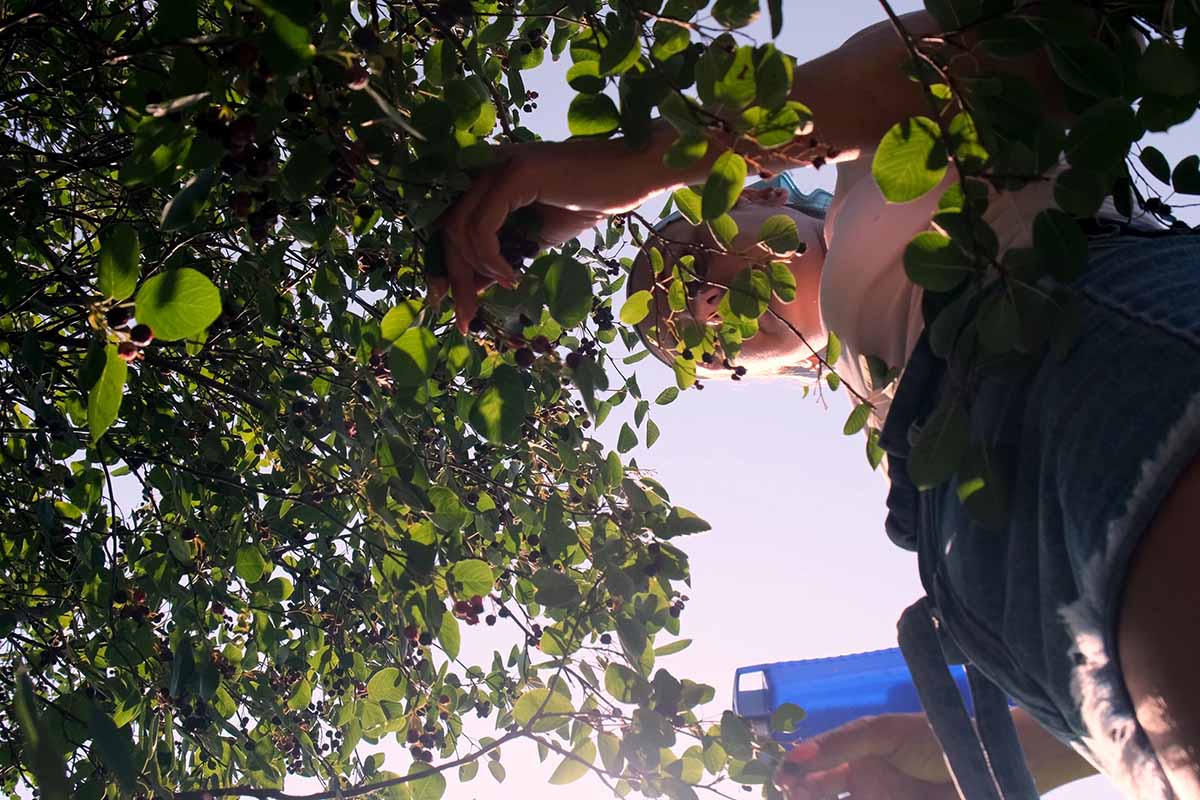
Certain cultivars can be a bit more tart or tangy than others. Test out a few berries before picking your whole bounty to be sure they taste good!
Pick the berries by hand, and aim for mid to late morning after the dew has evaporated but before the sun is too far overhead and it’s hot. This is the perfect time as the fruit will be firm, dry, and cool, rather than squishy, making them easier to pick.
You’ll notice that the fruits won’t always ripen at the same exact time, all at once. You might need to do multiple picking sessions to get your full harvest.

After picking, the berries should be washed and then used immediately for best quality and freshness or stored for later use. I’ll discuss storing berries in the next section.
Saskatoon berries deteriorate if not kept cool after harvesting, so if you’re out picking for a while without the ability to refrigerate your berries right away, bring a cooler.
Storing and Preserving
Sort through your Saskatoon berries, removing debris, leaves, and damaged berries.
Rinse them gently under cool running water, strain them in a colander, and then pat them dry with a clean towel.
Let the berries completely air dry after rinsing and patting off most of the moisture. This keeps them from going soft in storage.
Saskatoon berries retain their freshness if stored in the vegetable drawer or crisper in your refrigerator for up to two weeks.
You can also freeze your harvest for later use. Place the berries in a single layer on a baking sheet and set it in the freezer until they are frozen solid. Transfer them to an airtight container or resealable plastic bag and keep them in the freezer for up to a year.
Dehydration is another smart way to preserve your Saskatoons. In a dehydrator, spread the clean, dry fruits on a tray and then dehydrate them at a low temperature, around 135°F (57°C), for eight to 12 hours.
Store dehydrated berries in an airtight container or plastic zip-top bag. These can be kept in a cool, dark spot like a cabinet for several months.
Recipes and Cooking Ideas
Saskatoon fruits are sweet, sometimes tangy, and some people say they have a hint of nuttiness to them.
This flavor profile makes them versatile for use in both sweet and savory dishes.
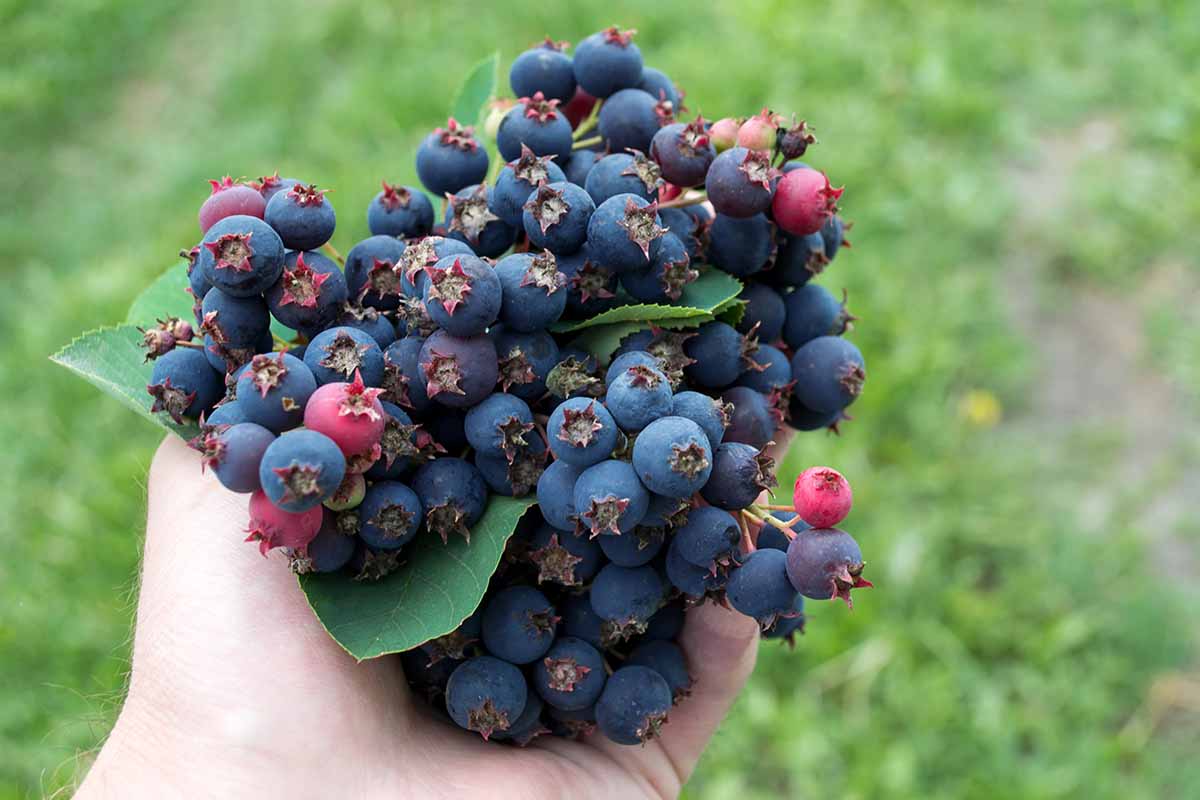
You can use them to make jams, jellies, and syrups as you might with other berries or fruit.
All kinds of baked goods are fantastic made with Saskatoons. Breads, muffins, pastries, and pies – or simply use Saskatoons instead of blueberries, raspberries or other small fruits for a new take on your old favorites.
During the last year or two, I’ve become obsessed with clafoutis, which is a French dessert that falls somewhere in the intersection between a custard, a tart, and a cake.
I’ve experimented with many different fruits in my clafoutis and I’ve even baked them in my outdoor wood oven, which takes the experience to another level.
Try Saskatoons in a clafoutis recipe. You won’t regret it. This recipe for red fruit custard cake on our sister site, Foodal, is very similar to clafoutis, so be sure to check it out.
You can also make fruit leather with Saskatoons. Just substitute the berries for other fruits like the strawberry used in this recipe for dried mango and strawberry fruit rolls, also from Foodal.
Quick Reference Growing Guide
| Plant Type: | Flowering deciduous shrub | Flower / Foliage Color: | White; green (spring and summer), yellow, orange, red (fall) |
| Native to: | Western Canada, northwestern United States | Water Needs: | Moderate |
| Hardiness (USDA Zone): | 2-9 | Maintenance: | Low |
| Bloom Time/Season: | Spring | Tolerance: | Clay soil, drought |
| Exposure: | Full sun to part shade | Soil Type: | Clay, loamy, sandy |
| Time to Maturity: | 6-8 years | Soil pH: | 6.0-8.0 |
| Spacing: | Width of mature spread | Soil Drainage: | Well-draining |
| Planting Depth: | 1/4 inch (seeds), depth of root system (transplants) | Attracts: | Birds, bees, butterflies |
| Height: | 3-26 feet | Uses: | Cottage gardens, food forests, edible hedges, native gardens, ornamental focal points, wildlife gardens, woodland gardens; beers, ciders, jams, jellies, juices, pies, wine |
| Spread: | 10-20 feet | Family: | Rosaceae |
| Growth Rate: | Slow to moderate, depending on cultivar | Genus: | Amelanchier |
| Pests & Diseases: | Birds; aphids, bud moths, mites, sawflies, scale, tarnished plant bug (lygus bug); fire blight, leaf spot, powdery mildew, rust | Species: | Alnifolia |
The Sensational Superpowers of Saskatoons
From urban farmers to ornamental landscapers, and everyone in between, A. alnifolia doesn’t disappoint.
With their delicate and fragrant spring blossoms and hearty, nutrition-packed fruit, Saskatoons serviceberry shrubs are as beautiful as they are forgiving.
From how to care for and maintain your plants to some fun and tasty recipe suggestions, we’ve covered everything you need to know to grow these Saskatoon serviceberry shrubs.
Are you growing Saskatoon serviceberry? Let us know in the comments section below. And I’m always on the hunt for new recipes, so if you’ve got one, please share it!
For more food forest plant suggestions, take a look at these berry-growing guides next:
